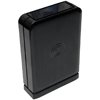- Qualcomm Launches Snapdragon 4 Gen 2 Mobile Platform
- AMD Launches Ryzen PRO 7000 Series Mobile & Desktop Platform
- Intel Launches Sleek Single-Slot Arc Pro A60 Workstation Graphics Card
- NVIDIA Announces Latest Ada Lovelace Additions: GeForce RTX 4060 Ti & RTX 4060
- Maxon Redshift With AMD Radeon GPU Rendering Support Now Available
Seagate FreeAgent GoFlex Desk 3TB

With our media collections growing larger by the day, it’s sad to look at a 2TB hard drive and picture it as not being “large enough” for our goods. To help remedy things a bit, Seagate recently released a 3TB external drive, and it today remains the only 3TB single drive offering. Let’s take a look and see if it’s worth your consideration.
Page 4 – Test System & Methodology; Iometer
For most of our performance-type content, we hold nothing back when explaining our methodologies and beliefs. But as this is simply an external storage review, we don’t feel there’s quite as important a need to do that. If you’ve read our other performance content, you already know how seriously we take our testing practises, as it’s obvious that coming up with an accurate end score for any benchmark is very important. In the case of external storage, we repeat all tests at least twice to verify that our results are accurate.
|
Component
|
Model
|
| Processor |
Intel Core i7-965 Extreme Edition – Quad-Core, 3.20GHz, 1.30v
|
| Motherboard |
Gigabyte GA-X58A-UD5 (Rev 1.0) – X58-based, F5 BIOS
|
| Memory |
Kingston HyperX – 12GB DDR3-1333 7-7-7-24-1T, 1.60v
|
| Graphics | EVGA GeForce GTX 285 1GB – GeForce 197.45 |
| Audio |
On-Board Audio
|
| Storage | |
| Power Supply | |
| Chassis | |
| Display |
Dell 24" 2408WFP
|
| Cooling | |
| Et cetera |
For our real-world transfer tests, the source files are stored on Intel’s X25-M G1 solid-state disk, which avails us a top-end read speed of around 250MB/s. Unless the USB device we’re testing with is able to write in excess of that, there should be no bottleneck.
Please note that due to the unique design of the FreeAgent GoFlex Desk 3TB, some small changes had to be made to our usual slew of benchmarks. First, HD Tune Pro had to be dropped due to its test requiring cluster sizes smaller than 4K. For Iometer, we had to change our Database test to begin the cluster sizes at 4K, not 512b like normal.
Also, because both PCMark Vantage (65,000 HDD Suite) and CrystalDiskMark (85MB/s via USB 2) delivered unrealistic results, we had to drop them as well.
Iometer 2006.07.27
To start things off, we’re using Iometer, a popular storage benchmarking application that’s as effective as it is customizable. It’s for both of those reasons that we choose to use it, and also thanks to the fact that it’s capable of outputting the results to both MB/s and IOPS (in/out operations per second). The latter is the value we focus on, as it’s become a standard for measuring performance in enterprise/IT environments.
Admittedly, running this test on most USB flash drives, especially 2.0 models, is not entirely important given the typical manner they’re used, but it’s our goal to see where one excels over another when dealing with such an intensive test. IOPS performance would be very important if you were to install an OS on a flash drive, as long as the bandwidth throughput is also good.



Where mechanical storage is concerned, we never expect to see super-high results with Iometer, but via USB 3, we see IOPS on par with other recently reviewed internal hard drives. Not a bad showing at all!
Support our efforts! With ad revenue at an all-time low for written websites, we're relying more than ever on reader support to help us continue putting so much effort into this type of content. You can support us by becoming a Patron, or by using our Amazon shopping affiliate links listed through our articles. Thanks for your support!





